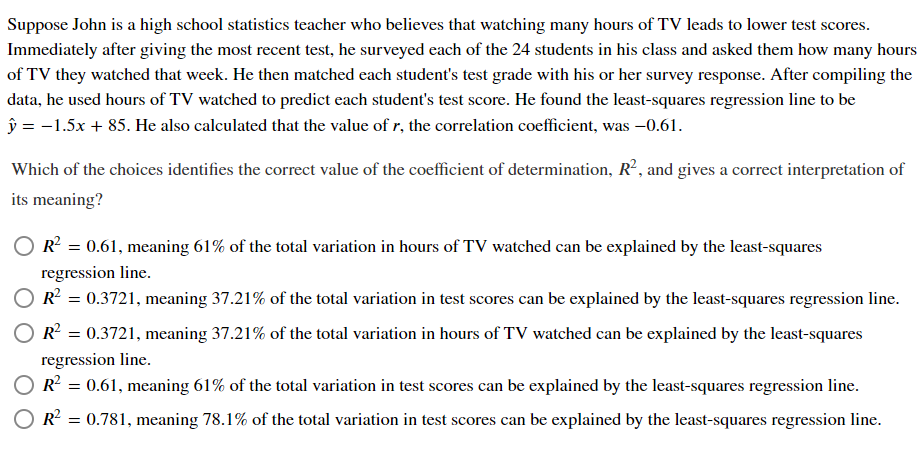Suppose John is a high school statistics teacher who believes that watching many hours of TV leads to lower test scores. Immediately after giving the most recent test, he surveyed each of the 24 students in his class and asked them how many hours of TV they watched that week. He then matched each student's test grade with his or her survey response. After compiling the data, he used hours of TV watched to predict each student's test score. He found the least-squares regression line to be ŷ = -1.5x + 85. He also calculated that the value of r, the correlation coefficient, was –0.61. Which of the choices identifies the correct value of the coefficient of determination, R², and gives a correct interpretation of its meaning? O R? = 0.61, meaning 61% of the total variation in hours of TV watched can be explained by the least-squares regression line. R = 0.3721, meaning 37.21% of the total variation in test scores can be explained by the least-squares regression line. O R? = 0.3721, meaning 37.21% of the total variation in hours of TV watched can be explained by the least-squares regression line. R = 0.61, meaning 61% of the total variation in test scores can be explained by the least-squares regression line. O R? = 0.781, meaning 78.1% of the total variation in test scores can be explained by the least-squares regression line.
Correlation
Correlation defines a relationship between two independent variables. It tells the degree to which variables move in relation to each other. When two sets of data are related to each other, there is a correlation between them.
Linear Correlation
A correlation is used to determine the relationships between numerical and categorical variables. In other words, it is an indicator of how things are connected to one another. The correlation analysis is the study of how variables are related.
Regression Analysis
Regression analysis is a statistical method in which it estimates the relationship between a dependent variable and one or more independent variable. In simple terms dependent variable is called as outcome variable and independent variable is called as predictors. Regression analysis is one of the methods to find the trends in data. The independent variable used in Regression analysis is named Predictor variable. It offers data of an associated dependent variable regarding a particular outcome.

Trending now
This is a popular solution!
Step by step
Solved in 2 steps with 2 images


